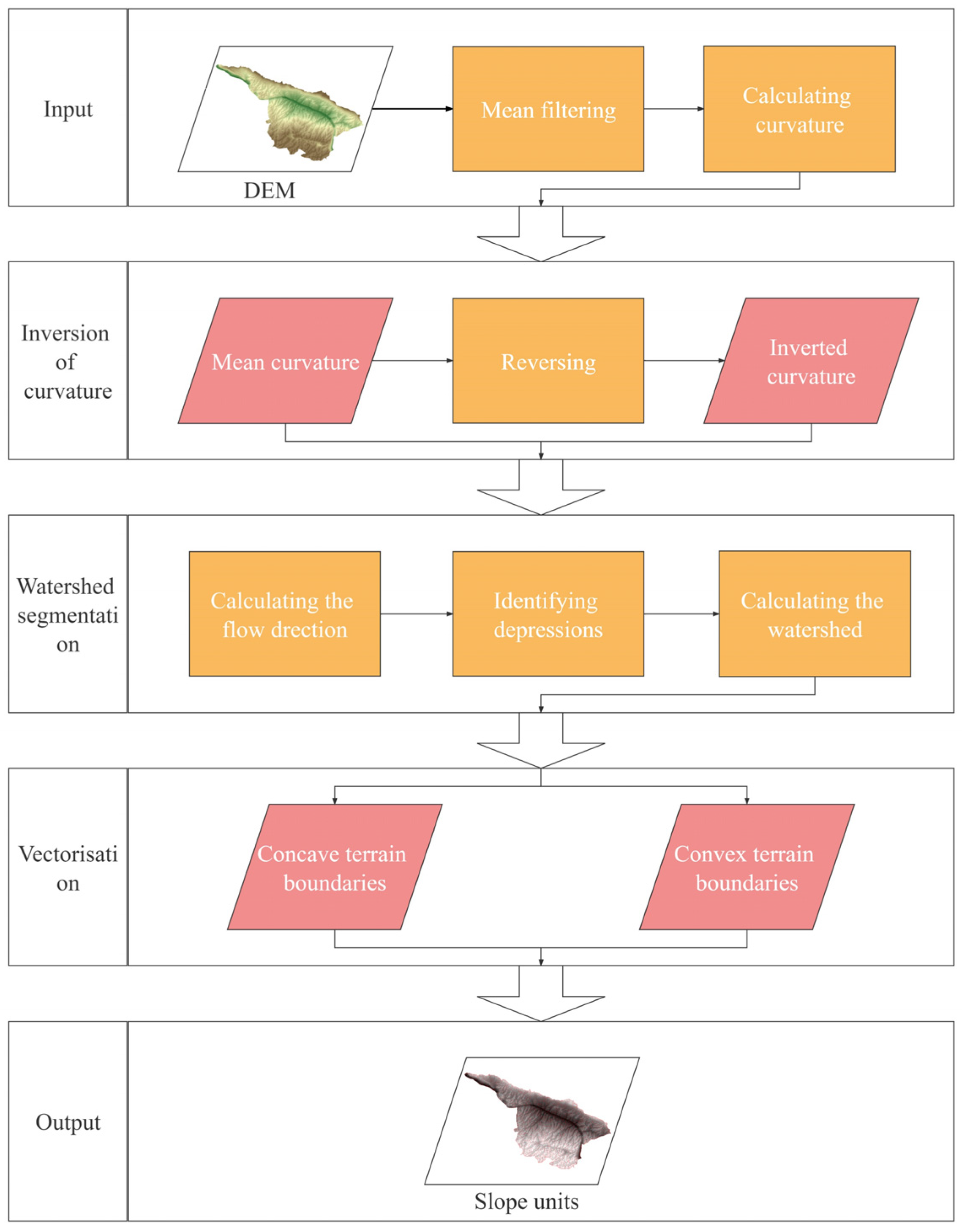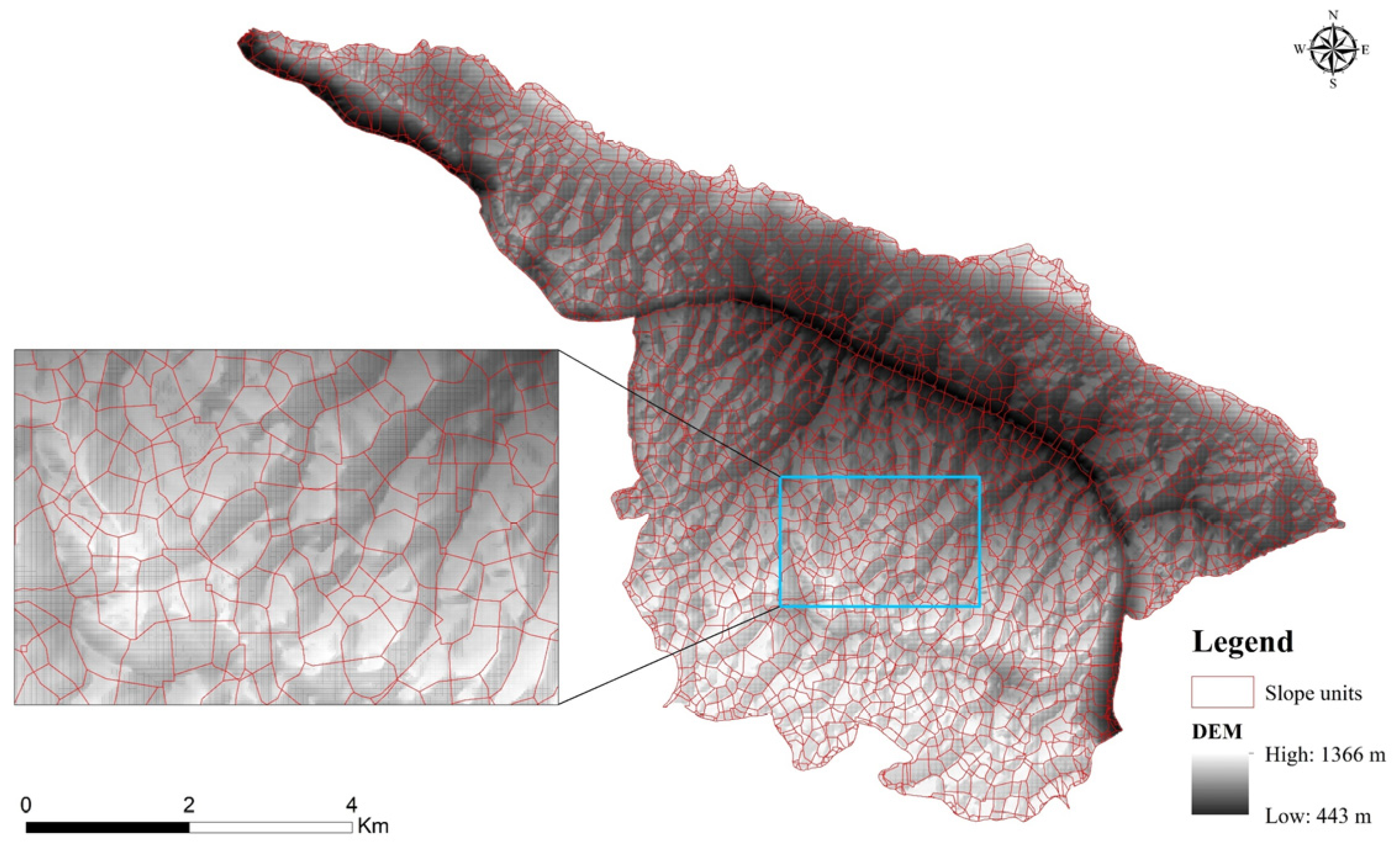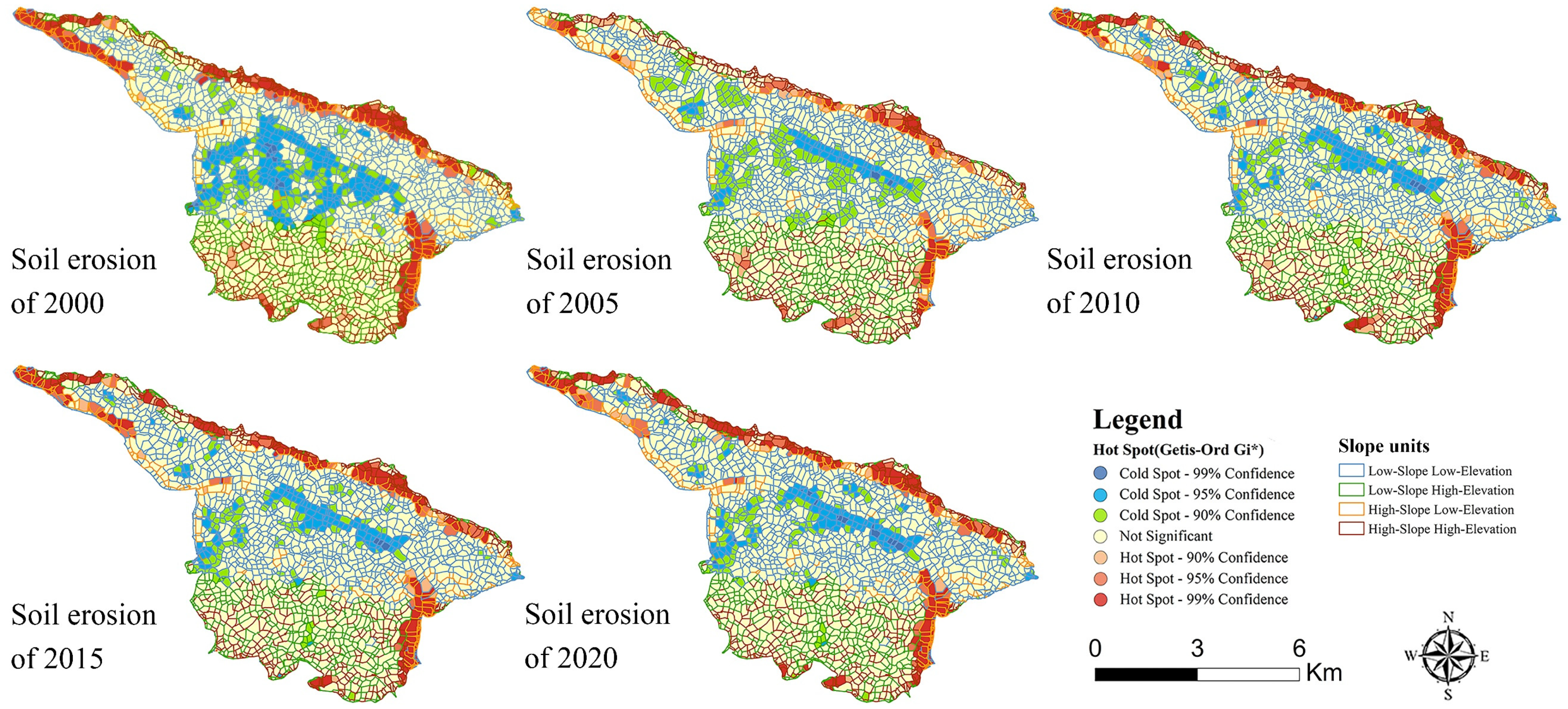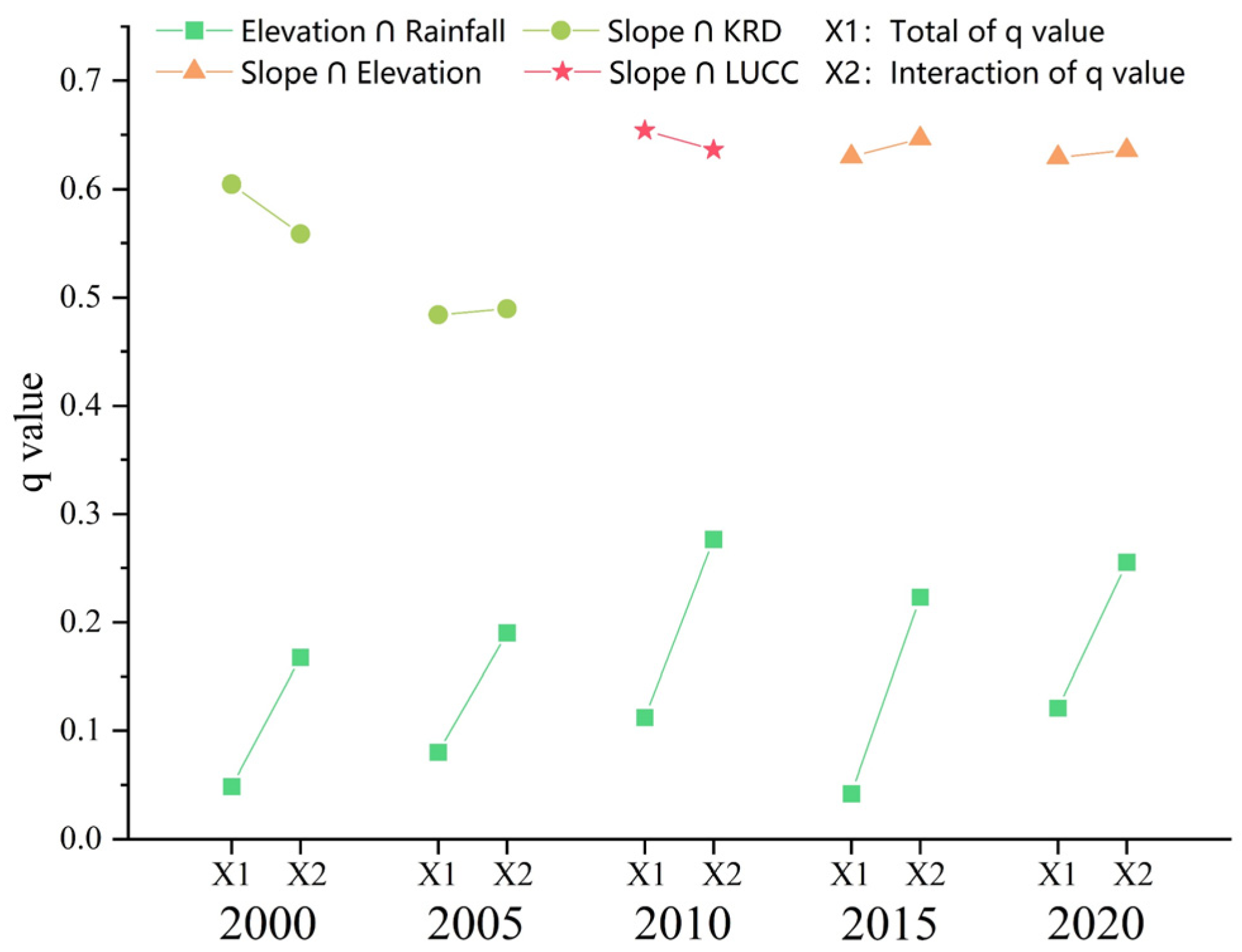Dynamic Evolution and Quantitative Attribution of Soil Erosion Based on Slope Units: A Case Study of a Karst Plateau-Gorge Area in SW China
Abstract
:1. Introduction
2. Materials and Methods
2.1. Study Area
2.2. Data
2.3. Methods
2.3.1. RUSLE Model
2.3.2. Geographical Detector
2.3.3. Slope Units
3. Results
3.1. Spatial and Temporal Dynamics of Soil Erosion
3.2. Regional Differentiation Based on Different Slope Units
3.2.1. Soil Erosion Class Transfer Based on Slope Units
3.2.2. Hotspot Analysis Based on Different Types of Slope Units
3.3. Quantitative Attribution of Soil Erosion Variability
3.3.1. Soil Erosion Risk Analysis
3.3.2. Single-Factor Analysis
3.3.3. Factor Interaction Analysis
4. Discussion
4.1. Spatial and Temporal Dynamics of Karst Soil Erosion
4.2. Soil Erosion Impact Driver Analysis
4.3. Challenges and Perspectives
5. Conclusions
Author Contributions
Funding
Institutional Review Board Statement
Informed Consent Statement
Data Availability Statement
Conflicts of Interest
References
- Chen, M.Y.; Ma, L.; Shao, M.G.; Wei, X.R.; Jia, Y.H.; Sun, S.C.; Zhang, Q.Y.; Li, T.C.; Yang, X.; Gan, M. Chinese zokor (Myospalax fontanierii) excavating activities lessen runoff but facilitate soil erosion—A simulation experiment. Catena 2021, 202, 105248. [Google Scholar] [CrossRef]
- Teng, M.J.; Huang, C.B.; Wang, P.C.; Zeng, L.X.; Zhou, Z.X.; Xiao, W.F.; Huang, Z.L.; Liu, C.F. Impacts of forest restoration on soil erosion in the Three Gorges Reservoir area, China. Sci. Total Environ. 2019, 697, 134164. [Google Scholar] [CrossRef] [PubMed]
- Lin, J.K.; Guan, Q.Y.; Tian, J.; Wang, Q.Z.; Li, Z.J.; Wang, N. Assessing temporal trends of soil erosion and sediment redistribution in the Hexi Corridor region using the integrated RUSLE-TLSD model. Catena 2020, 195, 104756. [Google Scholar] [CrossRef]
- Munodawafa, A. Assessing nutrient losses with soil erosion under different tillage systems and their implications on water quality. Phys. Chem. Earth Parts A/B/C 2007, 32, 1135–1140. [Google Scholar] [CrossRef]
- Luo, X.L.; Bai, X.Y.; Tan, Q.; Ran, C.; Chen, H.; Xi, H.P.; Chen, F.; Wu, L.H.; Li, C.J.; Zhang, S.R.; et al. Particulate organic carbon exports from the terrestrial biosphere controlled by erosion. Catena 2022, 209, 105815. [Google Scholar] [CrossRef]
- Li, Y.F.; Wang, Z.G.; Zhao, J.L.; Lin, Y.M.; Chen, A. Characterizing soil losses in China using data of 137Cs inventories and erosion plots. Catena 2021, 203, 105296. [Google Scholar] [CrossRef]
- Zhang, S.R.; Bai, X.Y.; Zhao, C.W.; Tan, Q.; Luo, G.J.; Cao, Y.; Deng, Y.H.; Li, Q.; Li, C.J.; Wu, L.H.; et al. Limitations of soil moisture and formation rate on vegetation growth in karst areas. Sci. Total Environ. 2022, 810, 151209. [Google Scholar] [CrossRef]
- Sirjani, E.; Sameni, A.; Moosavi, A.A.; Mahmoodabadi, M.; Laurent, B. Portable wind tunnel experiments to study soil erosion by wind and its link to soil properties in the Fars province, Iran. Geoderma 2018, 333, 69–80. [Google Scholar] [CrossRef]
- Rahman, M.R.; Shi, Z.H.; Cai, C.F. Soil erosion hazard evaluation—An integrated use of remote sensing, GIS and statistical approaches with biophysical parameters towards management strategies. Ecol. Modell. 2009, 220, 1724–1734. [Google Scholar] [CrossRef]
- Selmy, S.A.H.; Al-Aziz, S.H.A.; Jiménez-Ballesta, R.; Garcí a-Navarro, F.J.; Fadl, M.E. Modeling and Assessing Potential Soil Erosion Hazards Using USLE and Wind erosion in Integration with GIS Technique: Dakhla Oasis, Egypt. Agriculture 2021, 11, 1124. [Google Scholar] [CrossRef]
- Karalis, S.; Karymbalis, E.; Mamassis, N. Effects of lithology and geomorphology on sediment yield in karst mountainous catchments. Geomorphology 2019, 343, 119–128. [Google Scholar]
- Cao, Z.H.; Zhang, K.L.; He, J.H.; Yang, Z.C.; Zhou, Z.L. Linking rocky desertification to soil erosion by investigating changes in soil magnetic susceptibility profiles on karst slopes. Geoderma 2021, 389, 114949. [Google Scholar] [CrossRef]
- Wang, M.; Wang, H.S.; Jiang, C.; Sun, J.X. Spatial Soil Erosion Patterns and Quantitative Attribution Analysis in Southwestern China Based on RUSLE and Geo-Detector Model. J. Basic Sci. Eng. 2021, 29, 1386. [Google Scholar]
- Zhang, X.Q.; Hu, M.C.; Guo, X.Y.; Yang, H.; Zhang, Z.K.; Zhang, K.L. Effects of topographic factors on runoff and soil loss in Southwest China. Catena 2018, 160, 394–402. [Google Scholar] [CrossRef]
- Feng, T.; Chen, H.S.; Polyakov, V.O.; Wang, K.L.; Zhang, X.B.; Zhang, W. Soil erosion rates in two karst peak-cluster depression basins of northwest Guangxi, China: Comparison of the rusle model with 137cs measurements. Geomorphology 2016, 253, 217–224. [Google Scholar] [CrossRef]
- Li, Y.C.; Liu, C.X.; Zhao, C.Y.; Wang, C.J.; Zhang, H.; Ming, J.; Wang, Y. Assessment and spatial differentiation of sensitivity of soil erosion in Three Gorges Reservoir area of Chongqing. Acta Ecol. Sin. 2009, 29, 788–796. [Google Scholar]
- Zhu, Z.; Wang, J.X.; Hu, M.G.; Jia, L. Geographical detection of groundwater pollution vulnerability and hazard in karst areas of Guangxi Province, China. Environ. Pollut. 2018, 245, 627–633. [Google Scholar] [CrossRef]
- Morgan, R.P.C.; Nearing, M.A. Handbook of Erosion Modelling; Blackwell Publishing Ltd.: Hoboken, NJ, USA, 2011. [Google Scholar]
- Nearing, M.A. Soil erosion and conservation. In Environmental Modelling: Finding Simplicity in Complexity, 2nd ed.; Wiley: Hoboken, NJ, USA, 2013; pp. 365–378. [Google Scholar]
- Tian, Y.C.; Wang, S.J.; Bai, X.Y.; Luo, G.J.; Yan, X. Trade-offs among ecosystem services in a typical Karst watershed, SW China. Sci. Total Environ. 2016, 566, 1297–1308. [Google Scholar] [CrossRef]
- Long, M.Z.; Wu, K.H.; Xiong, K.N. Assessment of the applicability of the WEPP model(Hill slope Version) for soil erosion in karst rock desertification area, Guizhou Province. Carsol. Sin. 2014, 33, 201–207. [Google Scholar]
- Qin, W.; Guo, Q.K.; Cao, W.H.; Zhe, Y.; Yan, Q.H.; Shan, Z.J.; Zheng, F.L. A new RUSLE slope length factor and its application to soil erosion assessment in a Loess Plateau watershed. Soil Tillage Res. 2018, 182, 10–24. [Google Scholar] [CrossRef]
- Gao, J.B.; Wang, H. Temporal analysis on quantitative attribution of karst soil erosion: A case study of a peak-cluster depression basin in Southwest China. Catena 2019, 172, 369–377. [Google Scholar] [CrossRef]
- Febles-Gonzalez, J.M.; Vega-Carreno, M.B.; Tolon-Becerra, A.; Lastra-Bravo, X. Assessment of soil erosion in karst regions of Havana, Cuba. Land Degrad. Dev. 2012, 23, 465–474. [Google Scholar] [CrossRef]
- Xu, Y.Q.; Shao, X.M.; Kong, X.B.; Peng, J.; Cai, Y.L. Adapting the RUSLE and GIS to model soil erosion risk in a mountains karst watershed, Guizhou Province, China. Environ. Monit. Assess. 2008, 141, 275–286. [Google Scholar] [CrossRef]
- Dai, Q.H.; Peng, X.D.; Yang, Z.; Zhao, L.S. Runoff and erosion processes on bareslopes in the karst rocky desertification area. Catena 2017, 152, 218–226. [Google Scholar] [CrossRef]
- Carrara, A.; Cardinali, M.; Detti, R.; Guzetti, F.; Pasqui, V.; Reichenbach, P. GIS techniques and statistical models in evaluating landslide hazard. Earth Surf. Process. Landforms 1991, 16, 427–445. [Google Scholar] [CrossRef]
- Jia, N.; Mitani, Y.; Xie, M.W.; Tong, J.X.; Yang, Z.H. GIS deterministic model-based 3d large-scale artificial slope stability analysis along a highway using a new slope unit division method. Nat. Hazards 2015, 76, 873–890. [Google Scholar] [CrossRef]
- Wang, K.; Xu, H.; Zhang, S.J.; Weri, F.Q.; Xie, W.L. Identification and Extraction of Geomorphological Features of Landslides Using Slope Units for Landslide Analysis. ISPRS Int. J. Geo-Inf. 2020, 9, 274. [Google Scholar] [CrossRef] [Green Version]
- Ba, Q.Q.; Chen, Y.M.; Deng, S.S.; Yang, J.X.; Li, H.F. A comparison of slope units and grid cells as mapping units for landslide susceptibility assessment. Earth Sci. Inform. 2018, 11, 373–388. [Google Scholar] [CrossRef]
- Tanyas, H.; Rossi, M.; Alvioli, M.; van Westen, C.J.; Marchesini, I. A global slope unit-based method for the near real-time prediction of earthquake-induced landslides. Geomorphology 2019, 327, 126–146. [Google Scholar] [CrossRef]
- Jacobs, L.; Kervyn, M.; Reichenbach, P.; Rossi, M.; Marchesini, I.; Alvioli, M.; Dewitte, O. Regional susceptibility assessments with heterogeneous landslide information: Slope unit vs. pixel-based approach. Geomorphology 2020, 356, 107084. [Google Scholar] [CrossRef]
- Li, Y.; Liu, Z.Q.; Liu, G.H.; Xiong, K.N.; Cai, L.L. Dynamic variations in soil moisture in an epikarst fissure in the karst rocky desertification area. J. Hydrol. 2020, 591, 125587. [Google Scholar] [CrossRef]
- Legrain, X.; Berding, F.; Dondeyne, S.; Schad, P.; Chapelle, J. World Reference Base for Soil Resources 2014: International Soil Classification System for Naming Soils and Creating Legends for Soil Maps; FAO: Rome, Italy, 2014. [Google Scholar]
- Hu, F.; An, Y.L.; Xu, J. Preliminary discussion on concept and landscape features of “Semi-Karst”: A case study of Guizhou Province. Geogr. Res. 2015, 34, 1569–1580. [Google Scholar]
- Williams, J.R.; Jones, C.A.; Kiniry, J.R.; Spanel, D.A. The EPIC Crop Growth Model. Trans. ASAE 1989, 32, 0497–0511. [Google Scholar] [CrossRef]
- Arnoldus, H.M.J. An Approximation of the Rainfall Factor in the Universal Soil Loss Equation; John Wiley and Sons Ltd.: Hoboken, NJ, USA, 1980; pp. 127–132. [Google Scholar]
- Renard, K.G.; Foster, G.R.; Weesies, G.A.; McCool, D.; Yoder, D. Predicting soil erosion by water: A guide to conservation planning with the revised universal soil loss equation (RUSLE). In Agriculture Handbook; United States Government Printing: Washington, DC, USA, 1997; pp. 110–135. [Google Scholar]
- Liu, B.Y.; Nearing, M.A.; Shi, P.J.; Jia, Z.W. Slope Length Effects on Soil Loss for Steep Slopes. Soil Sci. Soc. Am. J. 2000, 64, 1759–1763. [Google Scholar] [CrossRef] [Green Version]
- Liu, B.T.; Song, C.F.; Shi, Z.; Tao, H.P. Correction Algorithm of Slope Factor in Universal Soil Loss Equation in Earth-Rocky Mountain Area of Southwest China. Soil Water Consevation China 2015, 8, 49–51. [Google Scholar]
- Jong, S.M.D. Derivation of vegetative variables from a landsat tm image for modelling soil erosion. Earth Surf. Proc. Land 1994, 19, 165–178. [Google Scholar] [CrossRef]
- Patil, R.J.; Sharma, S.K. Remote Sensing and GIS based modeling of crop/cover management factor (C) of USLE in Shakker river watershed. In Proceedings of the International Conference on Chemical, Agricultural and Medical Sciences (CAMS-2013), Kuala Lumpur, Malaysia, 29–30 December 2013; pp. 29–30. [Google Scholar]
- Durigon, V.L.; de Carvalho, D.F.; Antunes, M.A.H.; Oliveira, P.T.; Fernandes, M.M. NDVI time series for monitoring RUSLE cover management factor in a tropical watershed. Int. J. Remote Sens. 2014, 35, 441–453. [Google Scholar] [CrossRef]
- Li, Y.; Bai, X.Y.; Zhou, Y.C.; Qin, L.Y.; Tian, X.; Tian, Y.C.; Li, P.L. Spatial–temporal evolution of soil erosion in a Typical mountainous karst basin in SW China, based on GIS and RUSLE. Arab. J. Sci. Eng. 2016, 41, 209–221. [Google Scholar] [CrossRef]
- Zeng, C.; Wang, S.J.; Bai, X.Y.; Li, Y.B.; Tian, Y.C.; Yue, L.; Wu, L.H.; Luo, G.J. Soil erosion evolution and spatial correlation analysis in a typical karst geomorphology using RUSLE with GIS. Solid Earth 2017, 8, 721–736. [Google Scholar] [CrossRef] [Green Version]
- Wang, J.F.; Li, X.H.; Christakos, G.; Liao, Y.L.; Zhang, T.; Gu, X.; Zheng, X.Y. Geographical detectors-based health risk assessment and its application in the neural tube defects study of the Heshun region, China. Int. J. Geogr. Inf. Sci. 2010, 24, 107–127. [Google Scholar] [CrossRef]
- Wang, J.F.; Xu, C.D. Geodetector: Principle and prospective. Acta Geogr. Sin. 2017, 72, 116–134. [Google Scholar]
- Yan, Y.J.; Dai, Q.H.; Yuan, Y.F.; Peng, X.D.; Zhao, L.S.; Yang, J. Effects of rainfall intensity on runoff and sediment yields on bare slopes in a karst area, SW China. Geoderma 2018, 330, 30–40. [Google Scholar] [CrossRef]
- Xiong, K.N.; Zhu, D.Y.; Peng, T.; Yu, L.F.; Xue, J.H.; Li, P. Study on Ecological industry technology and demonstration for Karst rocky desertification control of the Karst Plateau-Gorge. Acta Ecol. Sin. 2016, 36, 7109–7113. [Google Scholar]
- Estrany, J.; Garcia, C.; Batalla, R.J. Hydrological response of a small mediterranean agricultural catchment. J. Hydrol. 2010, 380, 180–190. [Google Scholar] [CrossRef]
- Gonzalez-Hidalgo, J.; Batalla, R.; Cerdà, A.; De Luis, M. Contribution of the largest events to suspended sediment transport across the USA. Land Degrad. Dev. 2010, 21, 83–91. [Google Scholar] [CrossRef]
- Karamage, F.; Zhang, C.; Kayiranga, A.; Shao, H.; Fang, X.; Ndayisaba, F.; Nahayo, L.; Mupenzi, C.; Tian, G. USLE-based assessment of soilerosion by water in the Nyabarongo River catchment, Rwanda. Int. J. Environ. Res. Public Health 2016, 13, 835. [Google Scholar] [CrossRef] [Green Version]
- Song, F.J.; Wang, S.J.; Bai, X.Y.; Wu, L.H.; Wang, J.F.; Li, C.J.; Chen, H.; Luo, X.L.; Xi, H.P.; Zhang, S.R.; et al. A new indicator for global food security assessment: Harvested area rather than cropland area. Chin. Geogr. Sci. 2022, 32, 204–217. [Google Scholar] [CrossRef]
- Gao, J.B.; Wang, H.; Zuo, L. Spatial gradient and quantitative attribution of karst soil erosion in Southwest China. Environ. Monit. Assess. 2018, 190, 730. [Google Scholar] [CrossRef]
- Fu, J.T.; Li, G.Y.; Hu, X.T.; Li, Q.Z.; Yu, D.M.; Zhu, H.L.; Hu, X.G. Research status and development tendency of vegetation effects to soil reinforcement and slope stabilization. J. Eng. Geol. 2014, 22, 1135–1146. [Google Scholar]
- Xiong, K.N.; Li, J.; Long, M.Z. Features of soil and water loss and key issues in demonstration areas for combating karst rocky desertification. Acta Geogr. Sin. 2012, 67, 878–888. [Google Scholar]
- Gan, Y.X.; Dai, Q.H.; Fu, W.B.; Yan, Y.J.; Peng, X.D. Characteristics of soil erosion on Karst slopes under the artificial rainfall experiment conditions. Chin. J. Appl. Ecol. 2016, 27, 2754–2760. [Google Scholar]
- Xiong, K.N.; Chi, Y.K. The problems in southern China karst ecosystem in southern of China and its countermeasures. Ecol. Econ. 2015, 31, 23–30. [Google Scholar]
- Jiang, Y.; Gao, J.; Yang, L.; Wu, S.; Dai, E. The interactive effects of elevation, precipitation and lithology on karst rainfall and runoff erosivity. CATENA 2021, 207, 105588. [Google Scholar] [CrossRef]
- Zhang, S.R.; Bai, X.Y.; Zhao, C.W.; Tan, Q.; Luo, G.J.; Wu, L.H.; Xi, H.P.; Li, C.J.; Chen, F.; Ran, C.; et al. China’ s carbon budget inventory from 1997 to 2017 and its challenges to achieving carbon neutral strategies. J. Clean. Prod. 2022, 347, 130966. [Google Scholar] [CrossRef]
- Zhang, S.R.; Bai, X.Y.; Zhao, C.W.; Tan, Q.; Luo, G.J.; Wang, J.F.; Li, Q.; Wu, L.H.; Chen, F.; Li, C.J.; et al. Global CO2 consumption by silicate rock chemical weathering: Its past and future. Earth’s Futur. 2021, 9, e2020EF001938. [Google Scholar] [CrossRef]
- Ghosal, K.; Bhattacharya, S.D. A review of RUSLE model. J. Indian Soc. Remote Sens. 2020, 48, 689–707. [Google Scholar] [CrossRef]









| Rocky Desertification | None | Potential | Light | Moderate | High | Severe |
|---|---|---|---|---|---|---|
| Bedrock exposure rate (%) | 20< | 20–30 | 30–50 | 50–70 | 70–90 | >90 |
| α | 10 | 25 | 40 | 60 | 80 | 90 |
| Land Use | Arable Land | Garden Land | Wood Land | Shrub Land | Grass Land | Bare Land | Construction Land | Water | Bare Rock |
|---|---|---|---|---|---|---|---|---|---|
| p-value | 0.4 | 0.7 | 1 | 1 | 1 | 1 | 0 | 0 | 0 |
| 2000 | 2005 | 2010 | 2015 | 2020 | ||||||
|---|---|---|---|---|---|---|---|---|---|---|
| Erosion Ratio | Area Ratio | Erosion Ratio | Area Ratio | Erosion Ratio | Area Ratio | Erosion Ratio | Area Ratio | Erosion Ratio | Area Ratio | |
| No erosion | 0% | 59.12% | 0% | 66.38% | 0% | 46.29% | 0% | 45.37% | 0% | 45.10% |
| Slight | 3.39% | 8.04% | 0.94% | 3.58% | 4.81% | 13.84% | 5.06% | 14.24% | 3.34% | 11.29% |
| Light | 54.99% | 25.58% | 23.79% | 15.15% | 48.20% | 30.18% | 50.81% | 31.43% | 45.61% | 31.72% |
| Medium | 36.64% | 6.80% | 37.36% | 9.77% | 38.75% | 8.71% | 36.72% | 8.08% | 40.16% | 10.38% |
| Strong | 3.80% | 0.40% | 27.19% | 4.12% | 6.85% | 0.90% | 6.27% | 0.80% | 8.93% | 1.37% |
| Very strong | 0.86% | 0.05% | 9.63% | 0.96% | 0.80% | 0.06% | 0.92% | 0.06% | 1.42% | 0.13% |
| Severe | 0.32% | 0.01% | 1.09% | 0.04% | 0.59% | 0.02% | 0.22% | 0.01% | 0.54% | 0.02% |
| Total soil erosion (t·a−1) | 327,735.00 | 501,600.55 | 410,090.06 | 401,732.04 | 475,961.02 | |||||
Publisher’s Note: MDPI stays neutral with regard to jurisdictional claims in published maps and institutional affiliations. |
© 2022 by the authors. Licensee MDPI, Basel, Switzerland. This article is an open access article distributed under the terms and conditions of the Creative Commons Attribution (CC BY) license (https://creativecommons.org/licenses/by/4.0/).
Share and Cite
Shen, C.; Xiong, K.; Shu, T. Dynamic Evolution and Quantitative Attribution of Soil Erosion Based on Slope Units: A Case Study of a Karst Plateau-Gorge Area in SW China. Land 2022, 11, 1134. https://doi.org/10.3390/land11081134
Shen C, Xiong K, Shu T. Dynamic Evolution and Quantitative Attribution of Soil Erosion Based on Slope Units: A Case Study of a Karst Plateau-Gorge Area in SW China. Land. 2022; 11(8):1134. https://doi.org/10.3390/land11081134
Chicago/Turabian StyleShen, Chuhong, Kangning Xiong, and Tian Shu. 2022. "Dynamic Evolution and Quantitative Attribution of Soil Erosion Based on Slope Units: A Case Study of a Karst Plateau-Gorge Area in SW China" Land 11, no. 8: 1134. https://doi.org/10.3390/land11081134






